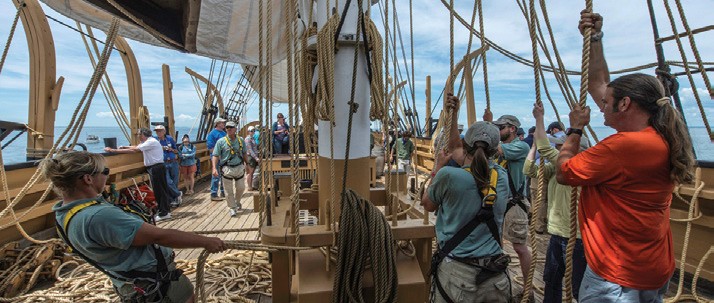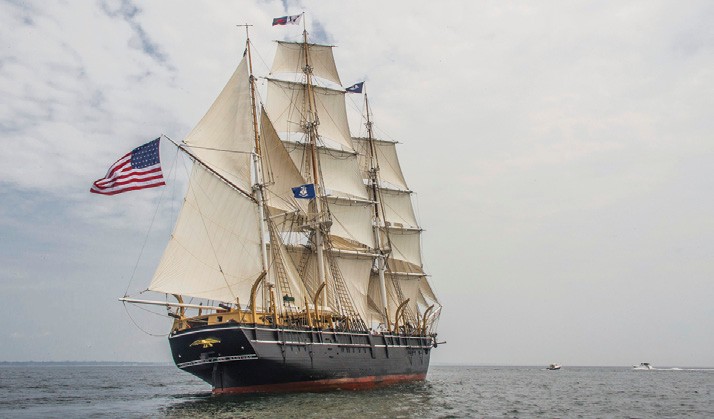By Tom Daniels, Shipwright & Sailing Deckhand
First night on the boat
 Every member of the Morgan’s crew has a daily station assignment. © Dennis Murphy/Mystic Seaport
Every member of the Morgan’s crew has a daily station assignment. © Dennis Murphy/Mystic Seaport
I’ve been working on this ship for three years as a builder, but coming on board the night before our first transit is different. It feels like arriving at summer camp, and our group of sailing deckhands is stoked. We scope out berths in the fo’c’sle. The mattresses feel good, and we look for the longest one. No luck – they’re all about six feet long. The core crew has long since staked out their spots and we try not to crowd them. We wonder where the snorers are and set up our bedding.
There are three groups of eight sailing deckhands that rotate in to assist the core crew during sailing trips on the Morgan. We come from throughout the Mystic Seaport Museum: interpretation, demonstration squad, administration, shipyard…all over. The core crew has been on board since May and the ship is no longer new to them. They’re all professional licensed mariners; they could sail the boat without us if they had to. We bring willing hands and muscle to help with hauling lines, loosing and furling sail, managing dock lines, whatever needs to be done. When you do this for a living, going aloft and furling sails is no big deal, and they’re happy to have us up there lending a hand.
By the next morning, we all know who the snorers are. The fo’c’sle is a pretty tight place after all. It doesn’t matter. Rested or not, we’re going sailing.
The Job
Our station assignments are handed out in the morning. These are the jobs that we’re responsible for during emergencies (e.g., handing out radios to officers, distributing life jackets, etc.) or during docking. We’re divided up into watches, port and starboard. Port watch handles the four forward staysails and the four sails on the foremast. Starboard watch handles the main staysail, the five sails on the main mast, the spanker and at times the gaff topsail. It’s a lot of sail to deal with, but starboard watch also gets to hang out in the shade of the skid deck, so there’s that.
The guests arrive, and there’s a flurry of activity: handling docking lines, setting up for the tug to tow us out, readying and setting sails. The rhythm is move, move, move. Wait. Move, move, move. Wait. The core crew is relaxed. They know what to expect; they know the thinking behind the rhythm. I’m more like a border collie, ears up, ready for a command to come out of the blue. In the spaces between activity I go over the lines and their locations. Port pin rail: Fore Course Clew, Bunt, Downhaul. Lower Topsail Clew and Bunt, Upper Topsail Clew and Bunt, Fore Staysail Halyard. Over and over, and that’s just one pin rail. I still don’t have it totally down.
Around us are the guests and the 38th Voyagers. The guests have been invited on board for any number of reasons: they’re donors to the project, politicians, maritime authors, Seaport employees, etc. The voyagers have submitted proposals for projects that they’ll do during the voyage. They write, draw, teach people how to use a sextant. There are musicians, teachers, historians, authors and more. The range and quality of their projects is impressive. The visitors and voyagers hum with excitement. They get one trip, and they’re on cloud nine.
For the deckhands, having a job takes some of the stardust off of the experience. We brace up the sails, sweat the lines, listening for a command, “Ease port, that’s well!” The visitors watch us and marvel about the operation of a tall ship. We secretly roll our eyes when people passionately debate the merits of different editions of Moby-Dick.
And then Roger Hambidge comes down from the anchor deck with a far off look. Roger is a master shipwright who started at Mystic Seaport working on the Morgan in the 1970s. He’s just been up at the bow, looking over the bulwarks at the bow wave, transfixed. “When I was first working on the bowsprit,” he tells me, “I used to look down through the gammon knees, and imagine what it would be like to see water rushing by. I can’t tell you how moved I am by this.” And just like that, the mood shifts. This voyage is significant and we both know it.
And that’s the thing about working on this ship; the experience swings from the mundane reality of pulling lines and setting fenders to these moments of awe and gratitude.
Going Aloft

The 1841 whaleship Charles W. Morgan sailed for the first time in nearly a century on her historic 38th Voyage this summer. © DennisMurphy/Mystic Seaport
“Pay attention, get a hold of something. It’d be silly to let go, wouldn’t it!” – Irving Johnson, on being aloft without safety equipment, from his film Around the Horn.
Going aloft was a big deal when I first came on the boat, and after six transits, it still is. There’s nothing more exciting, more focusing, than getting up into the rigging and working. That’s the thing – it’s not just going up high to hang out and enjoy the view, it’s going up to do a job. That distinction may not seem like much at first, but it changes the whole experience. You move with speed and purpose, but without being sloppy. Every handhold is deliberate, as is clipping in your harness, moving along the footropes, making the transition from the ratlines to standing on the cap. You call out. “Stepping on!” or “Stepping off!” when moving onto or off of a footrope that someone is already on, so that the sudden tension change doesn’t take them by surprise.
The first time I went up to furl sails I didn’t have time to be scared. I remember consciously thinking that I should be nervous, what with the footrope swinging beneath me and the whole rig swaying from side to side. But there was this job to do. Elizabeth Foretek, chief of the port watch, was beside me and I was determined to make a good showing. I wanted to work hard and fast. I wanted her to say, “Tom, you head up” the next time we needed people aloft. I had no idea what I was doing.
As she walked me through the sequence of hauling, gathering, stuffing, and busting, only The Job mattered. The deck below, the boats steaming along around us, the wind, all of it was in soft focus while the work was sharp and immediate.
The only exception to this was busting. When you bust a sail, you take the roll you’ve gathered up, and when the call comes, “One, two, BUST!” you heave the roll into an even tighter cylinder and pull it up and back on top of the yard. This means that instead of leaning out over the yard with your feet out behind you, suddenly you’re leaning back hard as the sail comes on top of the yard, with your feet below or even in front. Woah. Very unnerving.
When the job is done, everyone lays to deck (descends) and waits for the next command. We try to take in the view as we’re waiting for the person below us to descend, but the unspoken message is clear: your job is to be available, and when the work is done aloft, you need to be available on deck. So, down we go, with pine tar on our hands, breathing in the view, soaking it all in like a sponge. You can let yourself feel the rush once you get down.
Go to YouTube and look up “Atop the world on the Charles W. Morgan” to see core crewmember Cassie Streeter go aloft to loose the royal.
Miscellaneous moments
Finally working on the main royal yard (the highest yard on the ship) and feeling no fear at all, just exhilaration.
Being on a whaling ship in the midst of a pod of feeding humpback and finback whales. Honestly, it doesn’t get much cooler.
Sam Sikkema, the First Mate, speaking to the crew on the bullhorn: “We realize that you have a choice in sailing barks, and we appreciate you choosing the Charles W. Morgan for your sailing needs.”
The language of tall ships: That’s well! (good, you can stop) Come up! (instantly drop the line you’ve been pulling) Coil down for running! (coil the excess lines and leave them on deck)
The core crew discussing their next jobs: Spain, Texas, Samoa, the Great Lakes. I long to be 21 and unencumbered by a mortgage.
Final Thoughts
Sitting on deck with Ryan Leighton, the ship’s stowaway, late at night during our last transit back to New London. Aside from the tug’s engine ahead of us, the ship is quiet, the off-watch crew sacked out below. It’s a starry night, and as we pass by Point Judith, Ryan tells me he wants to read me something. It’s a passage from Edouard Stackpole’s The Charles W. Morgan, about her being towed from New Bedford to Mystic on November 5, 1941:
As the night settled down, and the General Greene towed them out of Buzzards Bay, the sea remained calm. High in the sky a bright moon revealed itself occasionally through a light cloud cover, and when its light was clear, the wraith that was the whaleship made the scene memorable in its unreality. Midnight passed, with Point Judith safely passed and the sea still peaceful…
(A newsman on board writes): Night adds much to the brief illusion that the past is close and the future shut out. I am writing on the bare wood mess table…A sputtering yellow-burning lantern, resting on a pair of cracked-leather bellows for added height, is the only light…It is not hard to hear the men and movements of a century ago…and the empty bunks seemed not quite empty.
I loved the work. The sheer physicality of it, getting better at it over time, knowing that what you did was essential to the operation of the boat, all of these things are great. However, sitting on deck that night, feeling history quietly repeat itself is what will stay with me.
Editor’s note: For photos, videos, information about the Morgan’s 38th Voyage and her passengers, go to mysticseaport.org and click on “38th Voyage.”
Tom Daniels exchanged an office job for a career in boat building in 2006. He began working with the Charles W. Morgan restoration team at Mystic Seaport in 2011 and is currently working on the schooner L.A. Dunton, also at Mystic Seaport. He documented the work on the Morgan through his Shipwright’s Blog, at mysticseaport.org/morganblog.



